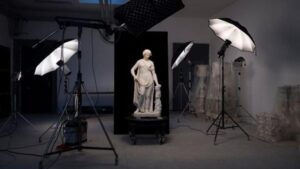
Photo session for Maenad statue at via della Lungara in Rome, ©FondazioneTorlonia, Ph. Lorenzo de Masi.
Not only do objects have provenances, but so do collections. One of the world’s finest privately held collections will be shared with the public starting later this month. The collection is housed in Rome, and while it is difficult to travel during this time, we are pleased to share a blog post about the upcoming exhibition in Italy. The following blog post was written by colleagues in Italy at Milestone Rome. Founded by two Roman locals, Milestone Rome is an independent cultural project aimed at spreading appreciation for the Eternal City and disseminating knowledge about its rich cultural heritage through art historical information enhanced by digital technologies. The group promotes academic-quality cultural content, and its website and app are also wonderful resources for travelers who visit Rome. Amineddoleh & Associates is pleased to share Milestone Rome’s post with our readers. Read more about the group on its great website.
The Storied Torlonia Collection of Ancient Marbles is Finally on View in Rome
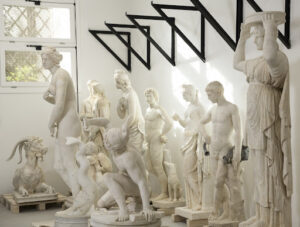
Group of restored statue at via della Lungara in Rome, ©FondazioneTorlonia, Ph. Lorenzo de Masi.
Almost 100 exquisite marble sculptures belonging to the renowned Torlonia Collection will be shown to the public on the occasion of the long-awaited exhibition I marmi Torlonia: Collezionare capolavori (“The Torlonia Marbles: Collecting Masterpieces”). After a turbulent year of delayed cultural events, the highly anticipated exhibition will be on view at the Capitoline Museums in Rome from October 14, 2020 until June 29, 2021. This will be its first stop on an unprecedented world tour. The exhibition is curated by two archaeologists and academics from the Accademia dei Lincei, famed Italian art historian Salvatore Settis (who was entrusted with the scientific project) together with art historian and professor Carlo Gasparri. The event is made possible thanks to a historic agreement between the public Italian Ministry of Cultural Heritage and Activities and Tourism and the private Fondazione Torlonia.
The successful negotiation, reached in 2016, comes after many years of a complex disputes between the noble Torlonia family and the Italian State. For this reason, the collection was hidden to the public for over 40 years. As a result, the exhibition in Rome will surely be one of the most important art events of the year or even of the decade.
The Troubled History of the Torlonia Collection
The Torlonia Family is a noble family from Rome that acquired a massive fortune in the 18th and 19th centuries overseeing finances for the Vatican. With its wealth, the family became major collectors of art. In fact, the complete Torlonia Collection is much larger than the selection of 96 pieces to be displayed as part of the exhibition. The collection includes 620 artworks that were catalogued in 1881 by Pietro Ercole Visconti as the result of a long series of acquisitions and excavations. The collection grew as the family purchased entire art collections that belonged to princely families in decline, such as the Giustiniani Collection. The Torlonia Collection was housed in a number of residences owned by the noble family, adding to the family’s prestige and title.
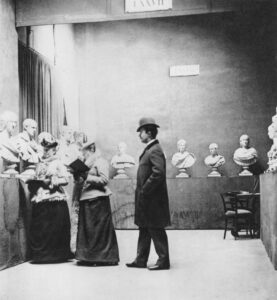
Giuseppe Primoli, A visit to the Torlonia Museum, 1898 ca., image via Wikimedia Commons.
The history of the Torlonia Collection took a turn at the beginning of the 19th century. At the time, it began assuming the form of a museum collection thanks to the Prince Alessandro Torlonia. In 1866, the prince acquired the villa of distinguished Cardinal Alessandro Albani. The villa is in Rome, located along the Via Salaria. When the prince acquired the villa, he also purchased the impressive collections of paintings and Greek and Roman sculptures found within. By the end of the 19th century, the collection included an extraordinary number of ancient marbles. Around 1875, the Prince Alessandro promoted a project to establish a Museum of Ancient Sculpture in an old grain warehouse along Via della Lungara near Palazzo Corsini. Dubbed “Torlonia Museum” it was open to small groups of visitors. But the project didn’t last, since in 1976 the building was converted into housing units and the collection locked up. The 2020 exhibition will display artworks that have not been on view since the 1970s.
Nowadays, the celebrated Torlonia Collection is not publicly visible, but it is the “most important private collection of ancient sculpture existing in the world,” according to the well-known art historian and critic Federico Zeri. What’s more, it is significant for many fields of study, including art history, archaeology, collecting history, restoration and museology. Due to the high-quality and complex nature of several collection which joined it, the Torlonia Collection has been then called “the collection of all collections.”
The Value of the Extraordinary Exhibition
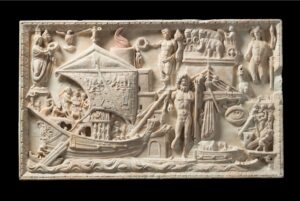
Porto relief, Torlonia Collection, ©FondazioneTorlonia, Ph. Lorenzo De Masi.
The anticipation surrounding this exhibition derives from many things. The art historical value of the sculptures themselves is incredible. The items include busts, reliefs, statues, sarcophagi, decorative elements and rare archaeological findings which have been always deemed as outstanding examples of ancient art. Also, the collection itself has an interesting history, as it was acquired over the centuries from a number of notable Romans. Moreover, the collection offers the opportunity to understand the prestigious and long history of antiquities collecting in Rome over a span of four centuries, between the 15th and the 19th century.
This is highlighted by the curators’ decision to configure the final room of the exhibition next to the Exedra of Marcus Aurelius, featuring the Lateran Ancient bronzes which were donated in 1471 by Pope Sisto IV’s to the “Roman People” and constituted the nucleus of what is considered as the first public museum in the world. In this way, the relationship between private collecting and public ownership are visually explained, highlighting the influential role of Rome in the art world.
A Torlonia Museum in Rome?
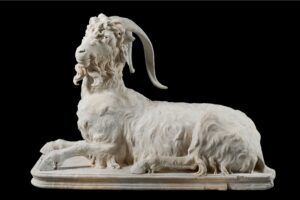
Statue of a goat at rest, Torlonia Collection ©FondazioneTorlonia, Ph. Lorenzo de Masi.
After being displayed at the newly restored exhibition venue at the Capitoline Museums in Rome, the traveling exhibit will tour around the world at a number of prestigious museums. As the details about these international agreements are revealed, the event schedule will be disclosed. It is also expected that the exhibition will end with the revelation of a permanent home in Rome, to be chosen by the Municipality of the City together with the Torlonia Family. This final home will permanently house the collection. This coveted collection will be yet another jewel in the crown of Rome’s artistic and cultural crown.
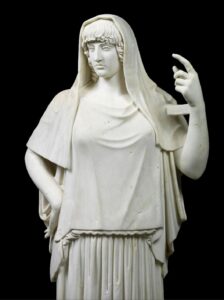
Hestia Giustiniani, Torlonia Collection, ©FondazioneTorlonia, Ph. Lorenzo De Masi.
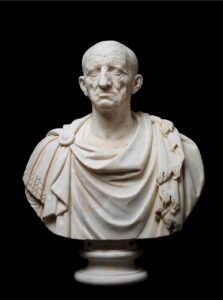
Old man from Otricoli, Torlonia Collection, ©FondazioneTorlonia, Ph. Lorenzo De Masi.